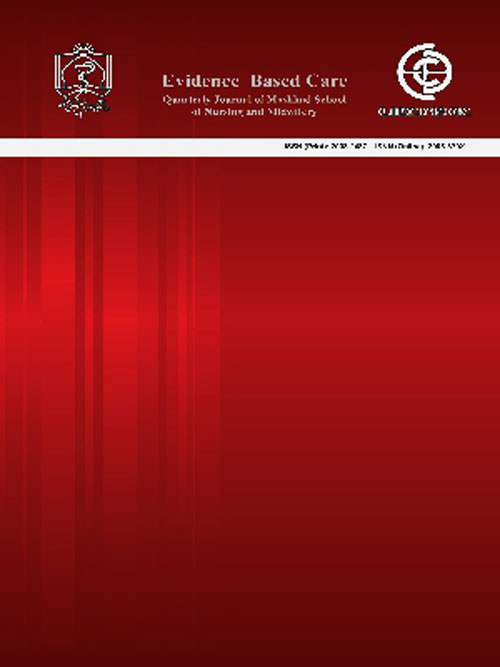فهرست مطالب

Evidence Based Care
Volume:12 Issue: 1, Spring 2022
- تاریخ انتشار: 1401/02/21
- تعداد عناوین: 8
-
-
Pages 7-13Background
The outbreak of coronavirus disease 2019 (COVID-19) in early 2020 has affected reperfusion time in patients with ST-segment elevation myocardial infarction (STEMI) across the globe.
AimThe present study aimed to assess the effect of the COVID-19 pandemic on the treatment management of STEMI.
MethodThis quantitative cross-sectional descriptive-analytical study investigated medical records of all patients (n=279) with STEMI who were consecutively admitted to Heshmatieh Hospital in Sabzevar city and underwent Primary Percutaneous Coronary Intervention (PPCI) in the last 9 months of 2019 (from April to December) as "Pre-pandemic group" (n=161) and the same period in 2020 as "post-pandemic group" (n=118). The data collection tools were a demographic information form and a checklist for recording treatment information.
ResultsThe average times from the symptom onset to first medical contact (FMC) and from FMC to the commencement of PPCI were significantly increased in the post-pandemic group, compared to those in the pre-pandemic group (870.50±1397.48 versus 348.80±399.20 min and 73.23±91.87 versus 52.68±27.46 min, respectively). The mean length of stay was reduced after the intervention in the post-pandemic group. Despite the reduction in the number of STEMI patients’ referrals in the post-COVID-19 pandemic period, the comparison of the referral of patients by month showed no significant difference between the two study groups before and after the COVID-19 pandemic.Implications for Practice: The COVID-19 pandemic caused treatment delay and reduced hospital stay among STEMI patients. The results of this study can be used to inform the community and better manage time-dependent diseases, such as STEMI, in the future.
Keywords: COVID-19, Primary percutaneous coronary intervention, ST-elevation myocardial infarction, Time-to-Treatments -
Pages 14-22Background
The body position change, as a common intervention in the intensive care unit (ICU), may affect endotracheal tube cuff pressure changes.
AimThis study investigated the effect of body position change and vital signals on endotracheal tube cuff pressure in children after bidirectional Glenn shunt surgery.
MethodThis randomized controlled trial was conducted on 29 children with an oral endotracheal tube hospitalized in the ICU after Glenn shunt surgery. The endotracheal tube cuff pressure was measured at the patient’s bed placed at a 30-degree angle. Other positions included right and left lateral in bed at a 30° upward angle as well as right and left lateral in bed angle at a 45° angle, respectively. The measurements were repeated every 10 min three times in different positions. Vital signals were measured in each group. The data were analyzed using SPSS 20.
ResultsThe results showed a significant relationship (P<0.001) between the body position change and level of cuff pressure after positioning patient’s body on their right side at an angle of 30˚, left side at an angle of 30° (P=0.004), and right side at an angle of 45° (P=0.010). The results showed no significant correlation between vital signals and endotracheal tube cuff pressure, except in mean arterial pressure.Implications for Practice: It is recommended that endotracheal tube cuff pressure in patients should be checked and corrected (if necessary), after changing the patient’s body position.
Keywords: Cuff pressure, Endotracheal intubation, Vital signs -
Pages 23-30Background
Hemodialysis is the most commonly used method for dialysis; nonetheless, it causes some problems, such as the pain associated with fistula needle insertion. Pain relief is one of the main skills of nurses, and reflexology can be used as a golden key for this puzzle.
AimThe present study aimed to assess the effect of foot reflexology on the pain of arteriovenous fistula (AVF) access.
MethodThis parallel double-blind clinical trial study was conducted on 50 female patients referring to Imam Reza Medical Center in Tabriz, Iran, in 2020-2021. The participants were randomly allocated to two groups of intervention and control using block randomization in a 1: 1 ratio. The intervention group received foot reflexology before hemodialysis for 20 min (10 min for each foot), while the control group received routine ward care. The data were collected through demographic characteristics and visual analog scale (VAS) questionnaires. Data were analyzed in SPSS 23.
ResultsIn terms of place of residence, 96% and 88% of participants in the intervention and control groups lived in urban areas, respectively. Moreover, 72% and 64% of patients in the two groups of intervention and control had a history of hypertension, respectively. Furthermore, foot reflexology had a statistically significant effect on the mean score of pain intensity during three sessions of reflexology over time.Implications for Practice: It is recommended that foot reflexology be used to reduce the pain of needle entry into the arteriovenous fistula in hemodialysis patients since reflexology is non-invasive nursing care with an easy procedure and effective in pain relief.
Keywords: Arteriovenous fistula, hemodialysis, Pain, Patients, Reflexology -
Pages 31-39Background
Sleep disorders are one of the most common unpleasant symptoms in cancer patients. Foot reflexology is a systemic practice based on the stimulation of nerves in the body.
AimThis study aimed to determine the effects of foot reflexology massage on sleep quality in patients with colorectal cancer.
MethodThis clinical trial study was conducted on 60 patients with colorectal cancer at the Oncology Ward of Imam Hossein Hospital, Tehran, Iran, who were selected based on inclusion and exclusion criteria and equally divided into two groups of control and intervention, based on medical file numbers. Pittsburgh Sleep Quality Index (PSQI) was completed for both groups before intervention. Foot reflexology massage was performed in the intervention group. The PSQI questionnaire was completed for both groups afterward. Data were analyzed using SPSS software through Chi-square test, Fisher’s exact test, Mann-Whitney U test, Independent t-test, and Paired samples t-test.
ResultsThere was a significant relationship between the total score of sleep quality and its dimensions in the intervention group post-intervention (P<0.05). Foot reflexology massage significantly improved sleep quality in the intervention group (P<0.05). However, there was no significant relationship between the total score of sleep quality and its dimensions in the control group before and after the intervention (P>0.05). Implications for Practice: Foot reflexology massage improves the quality of life and sleep in patients with colorectal cancer. Therefore, it is suggested that this technique be included in nursing practices as a simple, low-cost, and practical treatment.
Keywords: Colorectal cancer, Foot Reflexology, Nursing, Quality of sleep -
Pages 40-47Background
Patients undergoing coronary artery bypass graft (CABG) surgery face a serious psychological problem called death anxiety, which can harm the patient physically, socially, and emotionally. White noise and Benson’s relaxation technique are among the complementary and effective treatments which help mitigate death anxiety in these patients.
AimThis study aimed to investigate the impact of white noise and Benson’s relaxation technique on death anxiety among patients undergoing CABG.
MethodThis randomized clinical trial study was performed on 60 hospitalized patients in Iran in 2020. The permutated block method was used to randomly divide the eligible participants into intervention and control groups. In the intervention group, participants accomplished Benson’s technique with white noise music on three consecutive occasions in the morning, afternoon, and before night sleep. The control group did not receive any intervention. The demographic and clinical characteristics form and Templer scale were used to collect data. Data were analyzed using SPSS software (Version 25).
ResultsThe mean±SD age of the participants was 61.97±8.80 and 64.81±6.53 years in the intervention and control groups, respectively. The results showed a significant decrease in the mean score of death anxiety in the intervention group (P<0.05), while this score increased in the control group compared to the pre-training scores (P<0.05).Implications for Practice: Nurses are recommended to use white noise and Benson’s relaxation techniques as an effective intervention to reduce death anxiety in patients undergoing CABG surgery, and include them in the patient care and education programs.
Keywords: Benson relaxation, Coronary artery bypass graft surgery death anxiety, White noise -
Pages 48-55Background
Anxiety of labor pain can affect new mothers' mental health and lead to labor dystocia. Emotional support during pregnancy and childbirth has been reported to be effective in the reduction of labor anxiety. It seems that Solution-Focused Brief Therapy (SFBT) would be the practical method for minimizing the anxiety and pain during labor.
AimThis study aimed to investigate the effect of SFBT on anxiety and labor pain in nulliparous women.
MethodThis randomized clinical trial was implemented on 110 nulliparous pregnant women, who could not attend childbirth preparation classes due to the COVID-19 pandemic at Hakim Hospital, Neyshabur, Iran, from September to December 2020. The sampling was conducted using the Convenience method, and block randomization was employed for the random allocation of two intervention and control groups. The intervention group received single-session SFBT in a personal counseling session, and the control group received routine care, including heat water bags and aromatherapy. The data were collected using a demographic characteristics questionnaire, Spielberger anxiety inventory, and visual analog scale. A P-value less than 0.05 was considered statistically significant.
ResultsThere were significant differences between stages regarding the mean scores of labor pain and anxiety (P<0.001, P<0.001). The interaction of group and stages (P=0.002, P=0.003) and the independent effect of the group were also significant (P<0.001, P<0.001).Implications for Practice: The SFBT approach could reduce anxiety and labor pain in nulliparous women who do not participate in childbirth preparation classes.
Keywords: Anxiety, COVID-19, Labor pain, Mental health, Solution-Focused Brief Therapy -
Pages 56-62BackgroundOperating room nurses are frequently exposed to high-risk physical and psychological factors leading to increased anxiety and job stress and reduced accuracy.AimThis study aimed to evaluate the effect of aromatherapy with damask rose on anxiety, accuracy and job stress in operating room nurses.MethodThis clinical trial study was conducted in 2021 on 60 operating room nurses in Qom, Iran. The subjects were selected by the convenience sampling method and randomly divided into two equal experimental and control groups using the random blocking method. In the experimental group, nurses were asked to inhale damask rose for 10 minutes. The control group was asked to inhale normal saline. Anxiety, accuracy and job stress were assessed before and after aromatherapy. Data were analyzed by SPSS software (version 22) and Chi-square test, Independent t-test, and paired t-test. P<0.05 was considered statistically significant.ResultsThe mean age of nurses was 32.21±6.17 years. After aromatherapy, the mean scores of anxiety and job stress significantly increased to 26.53 ± 4.00 (t=9.32, P<0.001) and 80.0 ±10.47 (t=7.06, P<0.001), respectively in experimental group. The mean score of accuracy significantly increased to 33.56 ± 3.69 in the experimental group after aromatherapy (t=8.21, P<0.001). The results showed statistically significant difference between the experimental and control groups in terms of anxiety (t=-7.29, P<0.001), accuracy (t=-2.48, P=0.016) and job stress (t=4.14, P<0.001) after aromatherapy.Implications for Practice: It is recommended to use aromatherapy with damask rose to reduce anxiety and job stress and improve accuracy among operating room nurses.Keywords: Aromatherapy, Damask Rose, Anxiety, Accuracy, Job Stress


